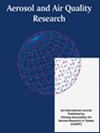新加坡石油工业硫排放对超细颗粒数浓度的影响
IF 2.5
4区 环境科学与生态学
Q3 ENVIRONMENTAL SCIENCES
引用次数: 1
摘要
17超细颗粒,定义为直径(dp)小于100纳米的颗粒,除了影响人体健康外,还是云凝结核的重要组成部分。19超细颗粒的主要来源包括交通排放和成核。新加坡是一个拥有石油化工产业的热带城市。为了确定超细颗粒的来源,2018年和2019年22日在新加坡进行了为期21年的数量大小分布观察。还监测了CO、CO 2、ch4和so2的浓度。西南季风季23号粒子浓度较高,东北季风季23号粒子浓度相对较低。CO浓度在早高峰时段有所上升,这与超细颗粒物浓度的小幅上升有关。高浓度的Aitken模式粒子27 (d p < 50 nm)事件发生在so2高浓度时期。下午so2浓度较高,主要是由于海风将沿海工业区的排放物输送到观测点。背景浓度30 (ΔCH 4)对ch4的增强与so2的增强呈准反比关系,因为这31种化学物质的主要排放源不同。颗粒数浓度(d p > 50 nm)与ch4主导气团CO浓度的升高(ΔCO)相关,表明33个不完全燃烧过程,如交通排放,对尺寸范围很重要。34相反,35个so2主导气团的艾特肯模式粒子(d p < 50 nm)的数量浓度增加,表明工业羽流的重要性。本文章由计算机程序翻译,如有差异,请以英文原文为准。
The Role of Sulfur Emission from the Petroleum Industry on Ultrafine Particle Number Concentration in Singapore
Ultrafine particles, defined as particles with a diameter ( d p ) smaller than 100 nm, serve as an important component of cloud condensation nuclei, in addition to impacting human health. The dominant sources of ultrafine particles include traffic emissions and nucleation. Singapore is a tropical city that hosts petrochemical industries. To identify the sources of ultrafine particles, a year-long observation of the number size distribution was conducted in Singapore in 2018 and 2019. The concentrations of CO, CO 2 , CH 4 , and SO 2 were also monitored. The particle number concentration during the southwest monsoon season was high, while that during the northeast monsoon period was relatively low. The CO concentration increased during the morning traffic rush hours, which was associated with relatively minor enhancements in ultrafine particle number concentration. The events for a high number concentration of the Aitken mode particles ( d p < 50 nm) were identified during high SO 2 concentration periods. The SO 2 concentration was high during the afternoon because the sea breeze transported the emissions from the coastal industrial area to the observation site. The enhancements in CH 4 from its background level ( Δ CH 4 ) and SO 2 had a quasi-inverse relationship, as the major emission sources of these two chemical species were different. The particle number concentration ( d p > 50 nm) correlated with the enhancements in CO concentration ( Δ CO) for CH 4 -dominant air masses, suggesting that incomplete combustion processes, such as traffic emission, are important for the size range. Conversely, the number concentration of the Aitken mode particles ( d p < 50 nm) increased for SO 2 -dominant air masses, suggesting the importance of industrial plume.
求助全文
通过发布文献求助,成功后即可免费获取论文全文。
去求助
来源期刊

Aerosol and Air Quality Research
ENVIRONMENTAL SCIENCES-
CiteScore
8.30
自引率
10.00%
发文量
163
审稿时长
3 months
期刊介绍:
The international journal of Aerosol and Air Quality Research (AAQR) covers all aspects of aerosol science and technology, atmospheric science and air quality related issues. It encompasses a multi-disciplinary field, including:
- Aerosol, air quality, atmospheric chemistry and global change;
- Air toxics (hazardous air pollutants (HAPs), persistent organic pollutants (POPs)) - Sources, control, transport and fate, human exposure;
- Nanoparticle and nanotechnology;
- Sources, combustion, thermal decomposition, emission, properties, behavior, formation, transport, deposition, measurement and analysis;
- Effects on the environments;
- Air quality and human health;
- Bioaerosols;
- Indoor air quality;
- Energy and air pollution;
- Pollution control technologies;
- Invention and improvement of sampling instruments and technologies;
- Optical/radiative properties and remote sensing;
- Carbon dioxide emission, capture, storage and utilization; novel methods for the reduction of carbon dioxide emission;
- Other topics related to aerosol and air quality.
 求助内容:
求助内容: 应助结果提醒方式:
应助结果提醒方式:


